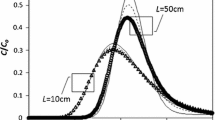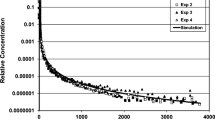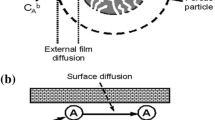Abstract
A general mathematical model to solve the advection–dispersion transport equation for multiple solutes was developed, where the dual porosity mobile–immobile mass transfer, the two-site non-equilibrium model and first-order transformation reactions were included. The two-site model was expressed with an equilibrium sorption term and a kinetic term. One of three kinetic models could be used: the non-linear, the bilinear and the pore diffusion model. The traditional Freundlich or Langmuir isotherms were employed to simulate no-interaction between the solutes, but with the extended Freundlich or extended Langmuir isotherms, a competitive sorption could be simulated. The transport equation was solved with the Moving Concentration Slope method. The mathematical model was tested and further simplified by using real data from soil column experiments, with 1,2-cis-dichloroethene and trichloroethene as model contaminants and silica gel and real soil samples as porous medium.



Similar content being viewed by others
References
Allen-King, R. M., Groenevelt, H., James Warren, C., & Mackay, D. M. (1996). Non-linear chlorinated-solvent sorption in four aquitards. Journal of Contaminant Hydrology, 22, 203–221. doi:10.1016/0169-7722(95)00089-5.
Ball, W. P., & Roberts, P. V. (1991). Long-term sorption of halogenated organic chemicals by aquifer material. 2. Intraparticle diffusion. Environmental Science & Technology, 25, 1237–1249. doi:10.1021/es00019a003.
Broughton, D. B. (1948). Adsorption isotherms for binary gas mixtures. Industrial & Engineering Chemistry, 40, 1506–1508. doi:10.1021/ie50464a036.
Brusseau, M. L., Jessup, R. E., & Rao, P. S. C. (1992). Modeling solute transport influenced by multiprocess nonequilibrium and transformation reactions. Water Resources Research, 28, 175–182. doi:10.1029/91WR02497.
Carta, G., & Cincotti, A. (1998). Film model approximation for non-linear adsorption and diffusion in spherical particles. Chemical Engineering Science, 53, 3483–3488. doi:10.1016/S0009-2509(98)00156-0.
Coats, K. H., & Smith, B. D. (1964). Dead-end pore volume and dispersion in porous media. Society of Petroleum Engineers Journal, 4, 73–84.
Connaughton, D. F., Stedinger, J. R., Lion, L. W., & Shuler, M. L. (1993). Description of time-varying desorption kinetics: Release of naphthalene from contaminated soils. Environmental Science & Technology, 27, 2397–2403. doi:10.1021/es00048a013.
Crank, J. (1979). The mathematics of diffusion. Oxford: Oxford University Press.
Danckwerts, P. V. (1953). Continuous flow systems: Distribution of residence times. Chemical Engineering Science, 2, 1–13. doi:10.1016/0009-2509(53)80001-1.
Do, D. D. (1998). Adsorption analysis: Equilibria and kinetics. London: Imperial College Press.
Fetter, C. W. (1993). Contaminant hydrology. Upper Saddle River: Prentice-Hall.
Glueckauf, E. (1955). Theory of chromatography. Part 10.— Formulae for diffusion into spheres and their application to chromatography. Transactions of the Faraday Society, 51, 1540–1551. doi:10.1039/tf9555101540.
Gu, T. (1995). Mathematical modeling and scale-up of liquid chromatography. Heidelberg: Springer.
Gu, T., Tsai, G.-J., Tsao, G. T., & Ladisch, M. R. (1990). Displacement effect in multicomponent chromatography. AIChE, 36, 1156–1162. doi:10.1002/aic.690360805.
Helfferich, F., & Klein, G. (1970). Multicomponent chromatography. Theory of interference. New York: Marcel Dekker.
Helfferich, F. G. (1997). Non-linear waves in chromatography III. Multicomponent langmuir and langmuir-like systems. Journal of Chromatography A, 768, 169–205. doi:10.1016/S0021-9673(96)00573-0.
Kaczmarski, K., Mazzotti, M., Storti, G., & Morbidelli, M. (1997). Modeling fixed-bed adsorption columns through orthogonal collocations on moving finite elements. Computers & Chemical Engineering, 21, 641–660. doi:10.1016/S0098-1354(96)00300-6.
Knudsen, J. G., Hottel, H. C., Sarofim, A. F., Wankat, P. C., & Knaebel, K. S. (1997). Heat and mass transfer. In R. Perry, & D. Green (Eds.), Perry’s chemical engineers’ handbook (pp. 72–74). USA: McGraw Hill.
Krishna, R., & Taylor, R. (1993). Multicomponent mass transfer. USA: Wiley.
Lee, P. H., & Kozak, J. J. (1987). Calculation of the tortuosity factor in single-phase transport through a structured medium. The Journal of Chemical Physics, 86, 4617–4627. doi:10.1063/1.452703.
Lee, L. S., Rao, P. S. C., Brusseau, M. L., & Ogwada, R. A. (1988). Nonequilibrium sorption of organic contaminants during flow through columns of aquifer materials. Environmental Toxicology and Chemistry, 7, 779–793. doi:10.1897/1552-8618(1988)7[779:NSOOCD]2.0.CO;2.
Lim, B.-G., Ching, C.-B., & Tan, R. B. H. (1995). Determination of competitive adsorption isotherms of enantiomers on a dual-site adsorbent. Separations Technology, 5, 213–228. doi:10.1016/0956-9618(95)00126-3.
Ma, Z., Katti, A., Lin, B., & Guiochon, G. (1990). Simple wave effects in two-component nonlinear liquid chromatography: Application to the measurement of competitive adsorption isotherms. Journal of Physical Chemistry, 94, 6911–6922. doi:10.1021/j100380a069.
Markham, E. C., & Benton, A. F. (1931). The adsorption of gas mixtures by silica. Journal of the American Chemical Society, 53, 497–507. doi:10.1021/ja01353a013.
Mauran, S., Rigaud, L., & Coudevylle, O. (2001). Application of the Carman–Kozeny correlation to a high-porosity and anisotropic consolidated medium: The compressed expanded natural graphite. Transport in Porous Media, 43, 355–376. doi:10.1023/A:1010735118136.
Moldrup, P., Yamaguchi, T., Hansen, J. A., & Rolston, D. E. (1992). An accurate and numerically stable model for one-dimensional solute transport in soils. Soil Science, 153, 261–273.
Moldrup, P., Yamaguchi, T., Rolston, D. E., Vestergaard, K., & Hansen, J. A. (1994). Removing numerically induced dispersion from finite difference models for solute and water transport in unsaturated soils. Soil Science, 157, 153–161.
Moon, H., & Kook-Lee, W. (1986). A lumped model for multicomponent adsorptions in fixed beds. Chemical Engineering Science, 41, 1995–2004. doi:10.1016/0009-2509(86)87116-0.
Morbidelli, M., Servida, A., Storti, G., & Carra, S. (1982). Simulation of multicomponent adsorption beds. Model analysis and numerical solution. Industrial & Engineering Chemistry Fundamentals, 21, 123–131. doi:10.1021/i100006a005.
Myers, T. E., Townsend, D. M., & Hill, C. B. (1998). Application of a semianalytical model to TNT transport in laboratory soil columns. U. S. Army Engineer Waterways Experiment Station.
Neville, C. J., Ibaraki, M., & Sudicky, E. A. (2000). Solute transport with multiprocess nonequilibrium: A semi-analytical solution approach. Journal of Contaminant Hydrology, 44, 141–159. doi:10.1016/S0169-7722(00)00094-2.
Nkedi-Kizza, P., Brusseau, M. L., Rao, P. S. C., & Hornsby, A. G. (1989). Nonequilibrium sorption during displacement of hydrophobic organic chemicals and calcium-45 through soil columns with aqueous and mixed solvents. Environmental Science & Technology, 23, 814–820. doi:10.1021/es00065a009.
Pignatello, J. J., & Xing, B. (1996). Mechanisms of slow sorption of organic chemicals to natural particles. Environmental Science & Technology, 30, 1–11. doi:10.1021/es940683g.
Rahman, M., Amiri, F., & Worch, E. (2003). Application of the mass transfer m.odel for describing nonequilibrium transport of HOCs through natural geosorbents. Water Research, 37, 4673–4684. doi:10.1016/S0043-1354(03)00430-5.
Rhee, H.-K., Aris, R., & Amundson, N. R. (1989a). First-order partial. Differential equations, 1. Theory and application of single equations. Mineola: Dover.
Rhee, H.-K., Aris, R., & Amundson, N. R. (1989b). First-order partial. Differential equations, 2. Theory and application of hyperbolic systems of quasilinear equations. Mineola: Dover.
Ruthven, D. M. (1984). Principles of adsorption and adsorption processes. USA: Wiley.
Rüttinger, S., Tobschall, H. J., Breiter, R., Hirsch, K., Salaices Avila, M. A., Neeße, T., et al. (2006). Natural Attenuation-Untersuchungen an einem mit LCKW kontaminierten Altdeponiestandort. Grundwasser, 11, 184–193. doi:10.1007/s00767-006-0144-9.
Salaices Avila, M. A. (2005). Experiment and modelling of the competitive sorption and transport of chlorinated ethenes in porous media. Goettingen: Cuvillier.
Salaices Avila, M. A., Breiter, R., & Mott, H. (2007). Development of a simple, accurate SPME-based method for assay of VOCs in column breakthrough experiments. Chemosphere, 66, 18–29. doi:10.1016/j.chemosphere.2006.05.069.
Santacesaria, E., Morbidelli, M., Servida, A., Storti, G., & Carra, S. (1982). Separation of xylenes on Y zeolites. 2. Breakthrough curves and their interpretation. Industrial & Engineering Chemistry Process Design and Development, 21, 446–451. doi:10.1021/i200018a017.
Schaefer, C. E., Schuth, C., Werth, C. J., & Reinhard, M. (2000). Binary desorption isotherms of TCE and PCE from silica gel and natural solids. Environmental Science & Technology, 34, 4341–4347. doi:10.1021/es000875d.
Sheindorf, C., Rebhun, M., & Sheintuch, M. (1981). A Freundlich-type multicomponent isotherm. Journal of Colloid and Interface Science, 79, 136–142. doi:10.1016/0021-9797(81)90056-4.
Sheindorf, C., Rebhun, M., & Sheintuch, M. (1983). Prediction of breakthrough curves from fixed-bed adsorbers with Freundlich-type multisolute isotherm. Chemical Engineering Science, 38, 335–342. doi:10.1016/0009-2509(83)85017-9.
Starr, J. L., & Parlange, J.-Y. (1979). Dispersion in soil columns: The snow plow effect. Soil Science Society of America Journal, 43, 448–450.
Starr, J. L., Parlange, J.-Y., & Braddock, R. D. (1982). Dispersion in soil columns: The precursor effect. Soil Science, 133, 111–115. doi:10.1097/00010694-198202000-00004.
Tobschall, H. J., Neeße, T., Rüttinger, S., Breiter, R., Poggel, K., & Salaices Avila, M. A. (2003). Teilprojekt 3: LHKW-Belastung am Standort “Im Reis”, Lauf an der Pegnitz. Gesellschaft zur Altlastensanierung in Bayern (GAB) mbH, München.
Toride, N., Leij, F. J., & van Genuchten, M. T. (1999). The CXTFIT code for estimating transport parameters from laboratory or field tracer experiments. Version 2.1. Research Report No. 137. U.S. Salinity laboratory, USDA, ARS, Riverside, CA.
Travis, C. C., & Etnier, E. (1981). A survey of sorption relationships for reactive solutes in soil. Journal of Environmental Quality, 10, 8–17.
van Genuchten, M. T. (1981). Non-equilibrium solute transport parameters from miscible displacement experiments, version 1.0. Research Report No. 119. U.S. Salinity laboratory, USDA, ARS, Riverside, CA.
van Genuchten, M. T., & Wierenga, P. J. (1976). Mass transfer studies in sorbing porous media 1. Analytical solutions. Soil Science Society of America Journal, 40, 473–480.
Wilke, C. R., & Chang, P. (1955). Correlation of diffusion coefficients in dilute solutions. AIChE, 1, 264–270. doi:10.1002/aic.690010222.
Zheng, C., & Bennett, G. D. (2002). Applied contaminant transport modeling. USA: Wiley.
Acknowledgments
The research is part of the Bavarian Network-Project “Sustainable Management of Contaminated Sites in Consideration of Natural Attenuation”. It is funded by the Bavarian State Ministry of the Environment, Public Health and Consumer Protection. The authors also wish to thank the financial support from the DAAD in Germany.
Author information
Authors and Affiliations
Corresponding author
Rights and permissions
About this article
Cite this article
Salaices Avila, M.A., Breiter, R. Modelling the Competitive Sorption Process of Multiple Solutes During their Transport in Porous Media. Environ Model Assess 14, 615–629 (2009). https://doi.org/10.1007/s10666-008-9168-0
Received:
Accepted:
Published:
Issue Date:
DOI: https://doi.org/10.1007/s10666-008-9168-0




